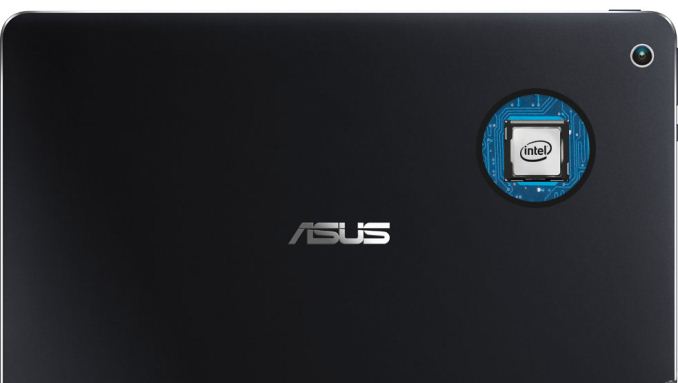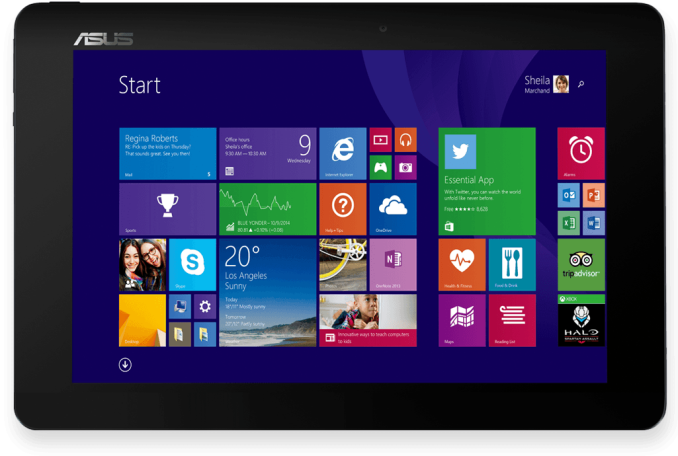ASUS Launches The Transformer Book Chi
by Brett Howse on March 30, 2015 6:45 PM EST- Posted in
- Tablets
- Asus
- Transformer Book

Though the Chi series was first announced at Computex way back in June 2014, it has been a long time getting to market. ASUS is now accepting pre-orders for two models of the Chi. The T100 Chi will be the replacement for the well-received Transformer Book T100, and the T300 Chi is the flagship model. Both will be fanless designs, and include the now traditional Transformer Book keyboard dock.
Starting with the T100 Chi, we get a nice update to a good design. The T100 Chi is a tablet convertible , so all of the components are in the 10.1 inch display. Speaking of the display, ASUS has went with a 16:10 ratio, with a 1920x1200 resolution. It is nice to see a few devices bucking the 16:9 trend, especially with tablets. It also features a laminated IPS display, which removes the air gaps between the different display layers. This is not a new feature of course, but one that has normally been reserved for more premium devices. And the premium feel does not end there, with the T100 Chi being made completely out of aluminum. The T100 is powered by the Intel Atom Z3775 quad-core processor, and has 2 GB of memory. Storage is eMMC in 32 and 64 GB tiers. The T100 Chi has a MSRP of $399, which is very much keeping in line with the previous T100, and comes with the keyboard dock.
| ASUS Transformer Book Chi Series | |||||
| T100 Chi | T300 Chi | ||||
| Processor | Intel Atom Z3775 (quad-core 1.46-2.39GHz, Intel HD GPU) | Intel Core M-5Y10/5Y71 (2C/4T 0.8-2.0 GHz/1.2-2.9GHz, Intel HD 5300 GPU) | |||
| Display | 10.1" 1920x1200 IPS Multitouch | 12.5" 1920x1080/2560x1440 IPS | |||
| Memory | 2 GB LPDDR3 | 4/8GB | |||
| Storage | 32/64GB eMMC plus Micro SDXC | 128GB SSD plus Micro SDXC | |||
| Networking | 802.11n dual-band + BT 4.0 | 802.11n dual-band + BT 4.0 | |||
| I/O | Micro USB 3.0, Micro HDMI, Headset | Micro USB 3.0, Micro HDMI, Headset | |||
| Battery | 31 Wh | 31 Wh | |||
| Dimensions | 10.1 x 6.9 x 0.3" (256.5 x 175.3 x 7.1mm) | 12.5 x 7.5 x 0.3" (317.5 x 190.5 x 7.62mm) | |||
| Weight | 1.3 lbs (590g), 2.4lbs (1.1kg) with keyboard | 1.6 lbs (726g), 3.2 lbs (1.45kg) with keyboard | |||
| MSRP | $399 32GB $449 64GB | $699 FHD, $899 WQHD | |||
The T300 Chi is 12.5 inch tablet, with the same laminated display as the T100, but we are back to the 16:9 ratio. Two resolutions are offered, with a 1920x1080 model being the mainstream version, or you can opt for a WQHD 2560x1440 version as well. The 1080p model comes with the Intel Core M-5Y10 CPU, 4 GB of memory, and a 128 GB SSD with micro SDXC expansion. The higher resolution T300 Chi will come with the Intel Core M-5Y71, 8 GB of memory, and a 128 GB SSD with micro SDXC expansion. The tablet alone is just 1.6 lbs, and combined with the included keyboard dock, the weight doubles to 3.2 lbs.
Both models feature support for the ASUS Transformer Book Chi Active Stylus Pen, which has 256 pressure levels supported and could therefore be based on N-Trig technology is a Synaptics unit (Confirmed with ASUS).
The keyboard docks have always been the key to the Transformer Book series, and the Chi models feature a unique magnetic hinge to perform the connection. The new models also offer support for additional modes beside attached and detached, with flipped and tented now joining the capabilities. While they do not feature the kickstand of the Surface, if you do have somewhere to rest the tablet, the tent mode should offer some nice functionality.
The ASUS Transformer Book Chi T100 and T300 are available for pre-order starting today.
Source: ASUS













19 Comments
View All Comments
HideOut - Monday, March 30, 2015 - link
Wireless N, really?AC me please. Hell my two year old cell phone is even AC.
nandnandnand - Monday, March 30, 2015 - link
I would replace an AMD APU laptop with a Skylake version of T300 Chi.WorldWithoutMadness - Monday, March 30, 2015 - link
Are you sure these use N-trig technology? Can you confirm it directly to ASUS?Many people had already guessed that they would use synaptics technology from pen apperance which is strikingly similar to Dell's old synaptics pen.
256 pressure level is not solely exclusive to n-trig as synaptics also has 256.
az060693 - Monday, March 30, 2015 - link
I hope they don't use Synaptics. Dell's implementation of a Synaptics pen digitizer was terrible.WorldWithoutMadness - Monday, March 30, 2015 - link
That's what I'm hoping for as well but I don't see N-trig mentioned everywhere else except this site, not even the cited source on the bottom of this article. Selling pen separately is synaptics specialty (and Dell) because well, you know the pen performance....That's why I'm doubting the credibility of N-trig mentioned in this article.
Daishi83 - Monday, March 30, 2015 - link
My understanding is that the latest version of the Synaptics pens from Dell are actually pretty good. It took them 3 or 4 trys but they made them usable eventually.WorldWithoutMadness - Monday, March 30, 2015 - link
Pretty good is relative, usable yes but do I want to live with it? No.I own dvp8 and reva02 (the old one). I saw the review of new pen, yeah they fixed some of the problems but for the love of god I'd rather use passive wacom (asus note 8) as the software support are better overall and not to mention I use clip studio paint. Better experience and no hassle.
If I wanted to use active pen, then n-trig is the answer (or Wacom AES). N-trig is under MS now, so everything else is much better than any other stuff that is growing anyway (atmel and synaptics) but I doubt OS neutrality in the long run. Wacom has better prospect as they have the experience from passive pen and their wacom aes in toshiba pretty much got stellar reviews.
Brett Howse - Tuesday, March 31, 2015 - link
I wasn't sure it was N-Trig, I said it could be. However I've clarified it with ASUS and it is in fact a Synaptics unit. Sorry for the confusion!WorldWithoutMadness - Tuesday, March 31, 2015 - link
Well, sorry for my misfire because I misread it.But thank you very much, you confirmed the technology surely where nobody else haven't yet!
MikeMurphy - Monday, March 30, 2015 - link
Brand new product based on the outgoing Bay Trail CPU rather than the Cherry Trail SOC? Odd.